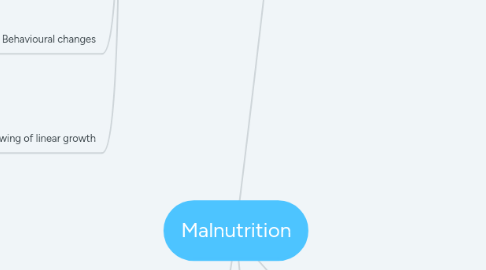
1. Signs & Symptoms
1.1. Nutrient Deficiency
1.1.1. Iron
1.1.1.1. Fatigue
1.1.1.2. Anaemia
1.1.1.3. Decreased cognitive function
1.1.1.4. Headache
1.1.1.5. Glossitis
1.1.1.6. Nail changes
1.1.2. Iodine
1.1.2.1. Goiter
1.1.2.2. Developmental delay
1.1.2.3. Mental retardation
1.1.3. Vitamin D
1.1.3.1. Poor growth
1.1.3.2. Rickets
1.1.3.3. Hypocalcemia
1.1.4. Vitamin A
1.1.4.1. Night blindness
1.1.4.2. Xerophthalmia
1.1.4.3. Poor growth
1.1.4.4. Hair changes
1.1.5. Folate
1.1.5.1. Glossitis
1.1.5.2. Megaloblastic anaemia
1.1.5.3. Neural tube defects
1.1.6. Zinc
1.1.6.1. Anaemia
1.1.6.2. Dwarfism
1.1.6.3. Hepatosplenomegaly
1.1.6.4. Hyperpigmentation
1.1.6.5. Hypogonadism
1.1.6.6. Acrodermatitis enteropathica
1.1.6.7. Diminished immune response
1.1.6.8. Poor wound healing
1.2. Physical Examination
1.2.1. Decreased subcutaneous tissue
1.2.2. Edema
1.2.3. Oral changes
1.2.3.1. Cheilosis
1.2.3.2. Angular stomatitis
1.2.3.3. Papillar atrophy
1.2.4. Abdominal findings
1.2.4.1. Abdominal distention due to poor musculature
1.2.4.2. Hepatomegaly due to fatty infiltration
1.2.5. Skin changes
1.2.5.1. Dry, peeling skin with exposed areas
1.2.5.2. Hyperpigmentation over areas of trauma
1.2.6. Nail changes
1.2.6.1. Fissured or ridged
1.2.7. Hair changes
1.2.7.1. Easily pulled out
1.2.7.2. Thin, sparse, brittle
1.3. Behavioural changes
1.3.1. Irritability
1.3.2. Apathy
1.3.3. Decreased social responsiveness
1.3.4. Anxiety
1.3.5. Attention deficit
1.4. Slowing of linear growth
2. Diagnosis
2.1. Laboratory Investigations
2.1.1. Hematological studies
2.1.1.1. Peripheral blood smear
2.1.1.2. RBC indices
2.1.2. Protein nutritional status
2.1.2.1. Serum albumin
2.1.2.2. Retinol-binding protein
2.1.2.3. Transferrin
2.1.2.3.1. Complete blood count
2.1.2.4. Creatinine
2.1.2.5. Blood Urea Nitrogen
2.2. History including a detailed dietary history
2.3. Growth measurements
2.3.1. Weight
2.3.2. Length/Height
2.3.3. Head circumference
